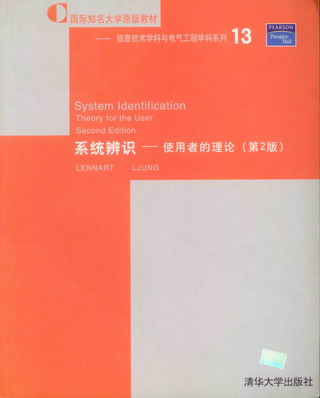作者简介:
Lennart Ljung教授,现任瑞典皇家工程科学院院土、瑞典皇家科学院院士、IFAC顾问、IEEE Fellow及多家国际刊物编委等职,在国际上拥有很高的学术地位。Lennart Ljung教授在系统辨识领域的贡献是世界公认的,可以说他及他所领导的“控制小组”在辨识方面所做的工作代表着系统辨识学科的前沿,尤其在辨识模型和辨识方法的一般性框架、快速辨识算法、辨识收敛性分析、可辨识性理论及闭环系统辨识等方面所做的贡献都是具有前瞻性和开创性的。
内容简介:
本书由四大部分内容构成:系统与模型、辨识方法、理论分析、使用者的选择。系统与模型部分主要论述线性时不变系统、线性时变系统和非线性系统的描述及其对应的模型结构。辨识方法部分主要论述各类模型参数辨识算法及其数值解方法,包括非参数时域与频域辨识方法、最小二乘辨识方法、线性回归辨识方法、预报误差辨识方法、子空间辨识方法、极大似然辨识方法、拟线性回归辨识方法、辅助变量辨识方法等。理论分析部分主要讨论了基于数据集性质的辨识算法的一致性、收敛性、可辨识性和参数估计的渐近分布等问题。使用者的选择部分主要阐述辨识目的、开环辨识实验设计、闭环辨识实验设计、采样时间的选择、数据预处理、辨识准则的选择、模型结构辨识、模型验证、辨识软件工具、辨识应用中的一些实际考虑和辨识应用等问题。
本书是世界多所知名大学,包括Stanford大学、MIT、Yale大学、澳大利亚国立大学、瑞典Linköping大学和Lund大学,系统辨识课程的教材,也应该成为我国自动化专业控制科学与控制工程学科研究生系统辨识课程的教材或教学参考书。本书还适合于自学者、有关技术人员、高校教师参考。
本书由系统与模型、辨识方法、理论分析、使用者的选择四部分内容构成。全书所引用的参考文献十分丰富,几乎包罗了系统辨识领域的许多重要文献和反映重要问题的原始文献。
英文目录
1 Introduction
1.1 Dynamic Systems
1.2 Models
1.3 An Archetypical Problem—ARX Models and the Linear Least Squares Method
1.4 The System Identification Procedure
1.5 Organization of the Book
1.6 Bibliography
Part i: systems and models
2 Time-Invariant Linear Systems
2.1 Impulse Responses, Disturbances, and Transfer Functions
2.2 Frequency-Domain Expressions
2.3 Signal Spectra
2.4 Single Realization Behavior and Ergodicity Results (*)
2.5 Multivariable Systems (*)
2.6 Summary
2.7 Bibliography
2.8 Problems
Appendix 2A: Proof of Theorem 2.2
Appendix 2B: Proof of Theorem 2.3
Appendix 2C: Covariance Formulas
3 Simulation and Prediction
3.1 Simulation
3.2 Prediction
3.3 Observers
3.4 Summary
3.5 Bibliography
3.6 Problems
4 Models of Linear Time-Invariant Systems
4.1 Linear Models and Sets of Linear Models
4.2 A Family of Transfer-Function Models
4.3 State-Space Models
4.4 Distributed Parameter Models (*)
4.5 Model Sets, Model Structures, and Identifiability: Some Formal Aspects(*)
4.6 Identifiability of Some Model Structures
4.7 Summary
4.8 Bibliography
4.9 Problems
Appendix 4A: Identifiability of Black-Box Multivariable Model Structures
5 Models for Time-Varying and Nonlinear Systems
5.1 Linear Time-Varying Models
5.2 Models with Nonlinearities
5.3 Nonlinear State-Space Models
5.4 Nonlinear Black-Box Models: Basic Principles
5.5 Nonlinear Black-Box Models: Neural Networks, Wavelets and Classical Models
5.6 Fuzzy Models
5.7 Formal Characterization of Models (*)
5.8 Summary
5.9 Bibliography
5.10 Problems
Part ii: methods
6 Nonparametric Time-and Frequency-Domain Methods
6.1 Transient-Response Analysis and Correlation Analysis
6.2 Frequency-Response Analysis
6.3 Fourier Analysis
6.4 Spectral Analysis
6.5 Estimating the Disturbance Spectrum (*)
6.6 Summary
6.7 Bibliography
6.8 Problems
Appendix 6A: Derivation of the Asymptotic Properties of the Spectral Analysis Estimate
7 Parameter Estimation Methods
7.1 Guiding Principles Behind Parameter Estimation Methods
7.2 Minimizing Prediction Errors
7.3 Linear Regressions and the Least-Squares Method
7.4 A Statistical Framework for Parameter Estimation and the Maximum Likelihood Method
7.5 Correlating Prediction Errors with Past Data
7.6 Instrumental-Variable Methods
7.7 Using Frequency Domain Data to Fit Linear Models (*)
7.8 Summary
7.9 Bibliography
7.10 Problems
Appendix 7A: Proof of the Cramer-Rao Inequality
8 Convergence and Consistency
8.1 Introduction
8.2 Conditions on the Data Set
8.3 Prediction-Error Approach
8.4 Consistency and Identifiability
8.5 Linear Time-Invariant Models: A Frequency-Domain Description of the Limit Model
8.6 The Correlation Approach
8.7 Summary
8.8 Bibliography
8.9 Problems
9 Asymptotic Distribution of Parameter Estimates
9.1 Introduction
9.2 The Prediction-Error Approach: Basic Theorem
9.3 Expressions for the Asymptotic Variance
9.4 Frequency-Domain Expressions for the Asymptotic Variance
9.5 The Correlation Approach
9.6 Use and Relevance of Asymptotic Variance Expressions
9.7 Summary
9.8 Bibliography
9.9 Problems
Appendix 9A: Proof of Theorem 9.1
Appendix 9A: The Asymptotic Parameter Variance
10 Computing the Estimate
10.1 Linear Regressions and Beast Squares
10.2 Numerical Solution by Iterative Search Methods
10.3 Computing Gradients
10.4 Two-Stage and Multistage Methods
10.5 Local Solutions and Initial Values
10.6 Subspace Methods for Estimating State Space Models
10.7 Summary
10.8 Bibliography
10.9 Problems
11 Recursive Estimation Methods
11.1 Introduction
11.2 The Recursive Least-Squares Algorithm
11.3 The Recursive IV Method
1l.4 Recursive Prediction-Error Methods
11.5 Recursive Pseudolinear Regressions
11.6 The Choice of Updating Step
11.7 Implementation
11.8 Summary
11.9 Bibliography
11.10 Problems
Appendix 11A: Techniques for Asymptotic Analysis of Recursive Algorithms
Part iii: user's choices
12 Options and Objectives
12.1 Options
12.2 Objectives
12.3 Bias and Variance
12.4 Summary
12.5 Bibliography
12.6 Problems
13 Experiment Design
13.1 Some General Considerations
13.2 Informative Experiments
13.3 Input Design for Open Loop Experiments
13.4 Identification in Closed Loop: Identifiability
13.5 Approaches to Closed Loop Identification
13.6 Optimal Experiment Design for High-Order Black-Box Models
13.7 Choice of Sampling Interval and Presampling Filters
13.8 Summary
13.9 Bibliography
13.10 Problems
14 Preprocessing Data
14.1 Drifts and Detrending
14.2 Outliers and Missing Data
14.3 Selecting Segments of Data and Merging Experiments
14.4 Prefiltering
14.5 Formal Design of Prefiltering and Input Properties
14.6 Summary
14.7 Bibliography
14.8 Problems
15 Choice of Identification Criterion
15.1 General Aspects
15.2 Choice of Norm: Robustness
15.3 Variance-Optimal Instruments
15.4 Summary
15.5 Bibliography
15.6 Problems
16 Model Structure Selection and Model Validation
16.1 General Aspects of the Choice of Model Structure
16.2 A Priori Considerations
16.3 Model Structure Selection Based on Preliminary Data Analysis
16.4 Comparing Model Structures
16.5 Model Validation
16.6 Residual Analysis
16.7 Summary
16.8 Bibliography
16.9 Problems
17 System Identification in Practice
17.1 The Tool: Interactive Software
17.2 The Practical Side of System Identification
17.3 Some Applications
17.4 What Does System Identification Have to Offer?
Appendix I some concepts from probability theory
Appendix II some statistical techniques for linear regressions
ii.1 Linear Regressions and the Least Squares Estimate
ii.2 Statistical Properties of the Least-Squares Estimate
ii.3 Some Further Topics in Least-Squares Estimation
ii.4 Problems
References
Subject Index
Reference Index

